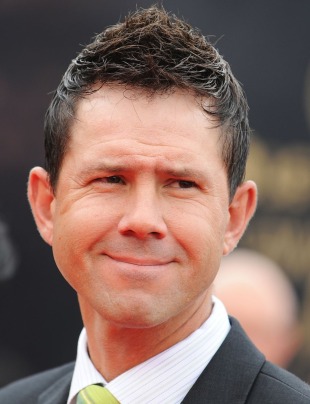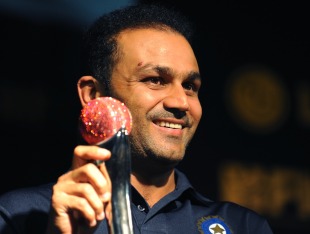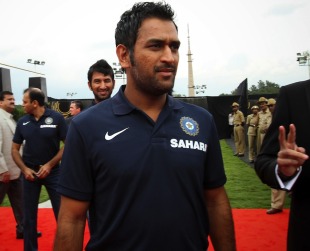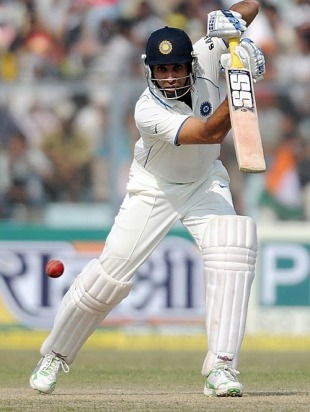| Live Cricket Streaming (Server 1) - Click Here To Watch |
| Live Cricket Streaming (Server 2) - Click Here To Watch |
| Live Cricket Streaming (Server 3) - Click Here To Watch |
| Live Cricket Streaming (Server 4) - Click Here To Watch |
| Live Cricket Streaming (Server 5) - Click Here To Watch |
| Live Cricket Streaming (Server 6) - Click Here To Watch |
Monday, October 11, 2010
LIVE CRICKET TV
Labels:
LIVE CRICKET TV
Saturday, October 9, 2010
Ponting named to lead ODI team of the year

| |||
Related Links News : Tendulkar wins Cricketer of the Year award News : Tendulkar in all major categories for ICC awards Players/Officials: Doug Bollinger | Stuart Broad | Paul Collingwood | AB de Villiers | MS Dhoni | Ryan Harris | Michael Hussey | Ricky Ponting | Sachin Tendulkar | Daniel Vettori |Shane Watson | |||
Ricky Ponting has been picked to lead the World ODI team of the year by a selection panel chaired by former West Indies captain Clive Lloyd. The team was announced during the ICC Awards in Bangalore on Wednesday. Ponting has been given this honour for the second time at these awards - he was also named captain in 2008. India captain MS Dhoni has been picked as wicketkeeper for the third straight year.
The XI includes five players from Australia, two from India, two from England, plus Daniel Vettori and AB de Villiers - the sole representatives from New Zealand and South Africa.
Lloyd, the chairman of the panel, said: "It was a very difficult task in selecting this year's ODI team but looking at the line-up I feel it has great balance and depth. It would be a tough team for anyone to beat."
Lloyd was joined on the panel by former Australia batsman Matthew Hayden, former England bowler Angus Fraser, former Zimbabwe player and England coach Duncan Fletcher and former India allrounder Ravi Shastri.
ODI team of the year: Sachin Tendulkar (India), Shane Watson (Australia), Michael Hussey (Australia), AB de Villiers (South Africa), Paul Collingwood (England), Ricky Ponting (capt, Australia), MS Dhoni (wk, India), Daniel Vettori (New Zealand), Stuart Broad (England), Doug Bollinger (Australia), Ryan Harris (Australia).
Tendulkar moves to No. 3 in ICC rankings
Sachin Tendulkar and VVS Laxman have moved up in the ICC Test rankings after their superb performances in the Mohali Test, which India won by one wicket. Tendulkar is in third place, his highest ranking since theHamilton Test against New Zealand in December 2002, while Laxman moves up four places to a career-best No. 8.
Both batsmen starred in India's thrilling win in the first Test against Australia. Laxman finished the run-chase in the fourth innings with an unbeaten 73, while Tendulkar top-scored in the first innings, scoring 98, and then contributed 38 in the second. He now trails Virender Sehwag - who is in second place with 851 points - by 13 points. Kumar Sangakkara, the Sri Lanka captain, tops the rankings with 874 points. Tendulkar has scored 1003 Test runs this year at an average of 83. 58.
There was also some good news for Zaheer Khan too, who won the Man-of-the-Match award in Mohali. He moved up to a career-best fifth position, thanks to his match haul of 8 for 137. (Click here for the top ten batting and bowling rankings.)
Sehwag is Test Cricketer of the Year

| |||
Related Links News : Tendulkar wins Cricketer of the Year award News : Tendulkar in all major categories for ICC awards Players/Officials: Virender Sehwag Teams: India Sites: Cricinfo ICC Site | |||
Virender Sehwag, the India opener, has been named the Test Player of the Year during the 2010 ICC Awards ceremony in Bangalore. He won the award, the first of his career, ahead of Sachin Tendulkar, Dale Steyn and Hashim Amla, who were the other nominees in the category.
"It's fantastic to win the award, to take over the title from Gautam Gambhir," Sehwag said after receiving the prize from Courtney Walsh. "I think I got motivated when Gambhir got this award last time, I was discussing with him that I hope I get it this time and I got it. I'm a huge fan of Test cricket and I love to play it more than Twenty20 or one-day cricket.
"When I was growing up, I was playing lot of 10-over, 12-over games, so I had to score off every ball, same thing I have continued. I followed my instincts and played in the same way in T20, ODI and Tests. It's a great strength to have."
Sehwag scored 1282 runs in ten Tests at an average of 85.46 between August 2009 and 2010, which was the period under consideration for the award. He was also named in the Test Team of the Year, which was captained by MS Dhoni.
Dhoni leads ICC Test Team of Year

| |||
Related Links News : Tendulkar wins Cricketer of the Year award News : Tendulkar in all major categories for ICC awards Players/Officials: Hashim Amla | James Anderson | Doug Bollinger | MS Dhoni | Jacques Kallis | Simon Katich | Kumar Sangakkara | Virender Sehwag | Dale Steyn | Graeme Swann| Sachin Tendulkar Sites: Cricinfo ICC Site | |||
India's captain, Mahendra Singh Dhoni, has been named as captain of the ICC's Test Team of the Year, an honour he also claimed in 2009, in a line-up that also includes two other players, Sachin Tendulkar and Dale Steyn, from last year's selection.
Five countries are represented in the 11-man line-up, which includes three Indians in Tendulkar, Dhoni and Virender Sehwag, two Englishmen in Graeme Swann and James Anderson, three South Africans in Hashim Amla, Jacques Kallis and Dale Steyn, two Australians in Simon Katich and Doug Bollinger, and one Sri Lankan in Kumar Sangakkara. Steyn is the only player to have featured in three consecutive years, having first been picked in 2008.
Clive Lloyd, the chairman of the awards selection panel, said: "This year's Test team has an extremely strong batting line-up that I think would set a suitable challenge to the world's best bowlers and coupling with the superb batting skills, I feel we have selected a bowling attack which could dismiss its own batting line-up."
Lloyd was joined on the panel by former Australia batsman Matthew Hayden, former England bowler Angus Fraser, former Zimbabwe player and England coach Duncan Fletcher and former India all-rounder Ravi Shastri. Statistics were available as a guide but were not necessarily the overwhelming factor in the choices made.
ICC Test Team of the Year 1 Virender Sehwag (Ind), 2 Simon Katich (Aus), 3 Sachin Tendulkar (Ind), 4 Hashim Amla (SA), 5 Kumar Sangakkara (SL), 6 Jacques Kallis (SA), 7 Mahendra Singh Dhoni (Ind, capt & wk), 8 Graeme Swann (Eng), 9 James Anderson (Eng), 10 Dale Steyn (SA), 11 Doug Bollinger (Aus).
Why Laxman's career proves England are better than Australia
 Australia struggle against Laxman. Laxman struggles against England. Therefore, Australia will struggle against England© Camerawork/Live Images
Australia struggle against Laxman. Laxman struggles against England. Therefore, Australia will struggle against England© Camerawork/Live ImagesLancashire’s VVS Laxman set England on course to win the Ashes with a match-winning and potentially series-turning innings for India against Australia in Mohali, a performance of classically Lancastrio-English cricketing resolve, fit to set alongside this nation’s great Ashes-triumphing performances of recent times, such as Pietersen’s 158 at The Oval in 2005, Botham’s 1981 mega-heroics, Australia’s top-order batting in 1985, and Kerry Packer running World Series Cricket at the same time as the 1978-79 series.
Laxman, alongside Ishant Sharma (who must now surely have inked himself into England’s line-up for Brisbane on November 25), saw Indiland home in a breathtaking late rearguard after Australia’s useless, impotent and morally inept seam bowlers had fortuitously scythed through the Englian top order.
The Baggy Greens, despite being only 0-1 down in the seven-match series, have now surely proved that they will never win a relevant cricket match again – any half-decent team would have appealed more convincingly for leg-before against Pragyan Ojha when just six more runs were needed to lose, and only a fracturing side staring into an abyss of imminent nothingness would have allowed their substitute fielder to narrowly miss the subsequent run-out attempt. Ricky Ponting’s best hope now is to avoid a 7-0 whitewash, and attempt to resign with his dignity and batting average still at least partially intact.
From an environmental point of view, it is a deeply regrettable shame that the obvious formality of England retaining the Ashes for the third series in a row after their triumphs in 2005 and 2009 will have to proceed to satisfy advertisers and spectators, at a cost to the planet of innumerable pointless aeroplane flights, when a ceremonial handing over of the Ashes to England captain Mahandrew Singh Strauss on the steps of Buckingham Palace would surely be more appropriate.
I’m confused.
I apologise if I have taken a slightly Anglo-centric view of the Mohali Test, a modern classic that fluctuated mesmerically amidst outstanding individual performances, crucial injuries and curious umpiring, and which featured one of the most dramatic single deliveries in cricket history. It is hard to think of a more incident-packed ball than Johnson’s to Ojha in the final over – if it was possible to score four for two off one ball, India almost did it. Australia should have taken the last wicket, then could have taken the last wicket, but instead gave away four of the required six runs, and lost a couple of balls later.
For those who missed it, Billy Bowden’s magic umpirical sonar apparently detected an edge that eluded the rest of the cricketing universe before Ojha’s pads diverted the ball from catapulting middle stump into the Punjab skies, whilst the batsman, perhaps momentarily deranged by the pressure and excitement of (a) the occasion, (b) there actually being an adequately sized crowd at a Test match in India, and (c) not being 100% lbw, set off for the most non-existent quick single in cricket history, as the Australian 12th man, Smith, hoved in on the ball and hurled it within centimetres of stump-splattering victory, only to see the leg-side fielders, similarly distracted by the heart-befuddling tension of the moment, admiringly watch his hurl scoot to the boundary for four decisive overhurls.
Perhaps the only individual balls that come close to matching it are the last ball of the 1999 World Cup semi-final, when South Africa finally choked harder than Australia in one of the great simultaneous choke-offs in sporting history, and the penultimate ball of the tied Test in 1960-61, when Grout was narrowly run out by Hunte’s sizzling throw from the boundary as he scampered for what would have been the winning third run. But to have two near-wickets and a boundary must be a first.
The finale of the Brisbane tie remains the most dramatic over in Test history – it began with five minutes remaining of the match, and Australia requiring six runs with three wickets remaining. There then followed, in just seven balls: five runs of varying degrees of luck, one catch, one dropped catch, one missed run-out, and two run-outs (both preventing the winning run, the second sealing the tie with a direct hit from midwicket). Plus one dot ball when not much happened. Something for everyone. One can only imagine how the average modern-day commentator would have relayed the action – presumably with a cocktail of window-shattering decibels and spontaneous combustion.
Mohali, a superb Test match throughout, gave the world the latest of Laxman’s sporadic masterpieces, innings of sublime perfection that have punctuated his oddly inconsistent career. English fans have never seen the Hyderabad Hyperstylist at his best. He has a worse Test average against England (34) than, amongst others, Russel Arnold, Boeta Dippenaar and Paul Reiffel (the 1990s version of Garfield Sobers). Against Australia, since 2000, Laxman averages 62, comfortably outperforming, amongst others, Russel Arnold, Boeta Dippenaar, Sachin Tendulkar, and every other batsman in world cricket.
Laxman’s career alone therefore proves, if proof were needed, that England are 82% better at cricket than Australia, and will certainly win the Ashes by approximately 3.22 Tests to 1.78. Unless Hauritz steps up a couple of gears, or Swann gets injured, or Australia’s superior flat-wicket seam-bowling proves decisive, or the innate class and home experience of their ageing batsmen outdoes England’s seldom consistently high-scoring line-up, or it is not uncharacteristically and unbrokenly cloudy for seven weeks, or Peter Siddle develops an unplayable googly, or England’s selectors panic and recall the late Wally Hammond in the vain hope he can repeat his 905 runs of 1928-29, or this happens, or that happens. Tough series to predict.
Meanwhile, as we English and our cricketing media obsess about the forthcoming confrontation in Baggy Greenland, the world’s current and former No. 1 nations bring their irritatingly short two-match series to a conclusion in Bangalore. In the frequently indigestible smorgasbord of an international cricket schedule that is force-rammed down the throats of the world’s fans, this is a rare case of underkill, like Federer playing Nadal over one set, or Usain Bolt taking on Tyson Gay in a 40-metre sprint, or Kiefer Sutherland starring as Jack Bauer in a new series of 9.
Always the artist, never the superstar
VVS Laxman inhabits a world of his own, an era of old-time virtue that we are reminded of all too infrequently these days

| |||
Related Links Peter Roebuck : The genius and the doubter Sambit Bal : The steel beneath the silk Features : 'These situations get the best out of me' - Laxman Analysis : India's Atlas, Australia's nemesis Bulletin : Magical Laxman seals thrilling one-wicket win Players/Officials: VVS Laxman Teams: India | |||
In a wonderfully charming way the world sometimes pauses, holds back from its relentless march forward, to look at timelessness, at things that defy the situations it seeks to create: a beautiful love story, a travelogue lazily told, a ghazal, a VVS Laxmaninnings.
When Laxman bats, he is almost dated, sepia tends to tinge the bright, colourful, high-resolution pictures that show him batting. He doesn't steal the impossible single, doesn't come storming back for a second like his life depended on it, doesn't snarl at somebody because he has a couple of seconds and doesn't know what to do with them.
He lets the moment breathe, gently sniffs at the serenity that inevitably surrounds him and takes his stance; his world is dictated by his speed and no one else's. Like Jonathan Livingston Seagull, he seems to search for a higher calm as the other seagulls scrap for anchovies around him.
Not that the scrapping is bad, not that the stolen second run is impure; it is just not him, not his world. When he was slogging in the IPL recently, his bat-speed awry, his body tilted at angles strange for strokeplay, the leg moving out of line to hit over midwicket rather than coming languidly towards the ball to stroke it past cover, he looked like a cheap imitation of the original. It didn't become him. It was an artist trying to enter the world of commerce; a world that pays millions to those who don't bat like him.
And he is understated - another disqualification from the world of commercial endorsements. When he uses the letter "i" it is only because it is in the middle of the word "win". He loves winning, he loves contributing to a win, but he is unlikely to be nudging someone to be in the first row of the photograph.
And so while the big cheques don't always appear, something else does: respect in his dressing room and in that of the opposition; like it does for Naseeruddin Shah, while the big cheques go to Salman Khan. But respect never goes out of fashion; it is something all performers crave, and he has it in abundance.
For a major part of his career he has batted at No. 6. It means the tail is a stone's throw away. It means the boundary riders are out for him, offering him the single to attack the rest. It means he stays not-out more often; once every sixth innings almost, compared to about one in 10 for Tendulkar and one in nine for Dravid. You might argue it boosts his average but the innings rarely go as far as they might have gone. Hence, only 16 centuries. Hence, too, the change in batting style; from a free-stroking player to someone who must guard his wicket and prolong the innings. Number six is a difficult position to bat in if you are a batsman who doesn't bowl because your numbers rarely look as good as those of the men who precede you.
| Down in Australia, they think we are daft but we have never bestowed on him the stature we have with Tendulkar, Dravid, Ganguly, and more lately with Sehwag | |||
That is why he has had to walk the selection tightrope far too often for a player of his ability. That is why many believe he has been underrated. Down in Australia they think we are daft, but we have never bestowed on him the stature we have on Tendulkar, Dravid, Ganguly, and more lately Sehwag. And so, every time there was a new kid on the block, the attention shifted towards Laxman. And yet in the last two years (from January 1, 2009, to be precise), he has scored a century every four Tests and averages 80.
Remember, too, that he doesn't play any other form of cricket at this level. It means he has to lift his game enormously, for standards of first class-cricket in India are poor, and quite simply, he wouldn't have played enough. It is an assignment that can be daunting for most and something he will have to live with for the rest of his career. Nobody knows how long that is going to be. He might have the spine but his back is asking too many questions and his knees aren't his best friends.
Many years ago a young Jonty Rhodes was batting with the legendary but ageing Graeme Pollock. After Jonty had called him for one single too many, the great man called him mid-pitch and said: "Young man, the athletics stops now and the cricket begins!"
The athletics may have stopped for VVS Laxman but the cricket continues to be magical. His place in the pantheon is assured.
Subscribe to:
Comments (Atom)